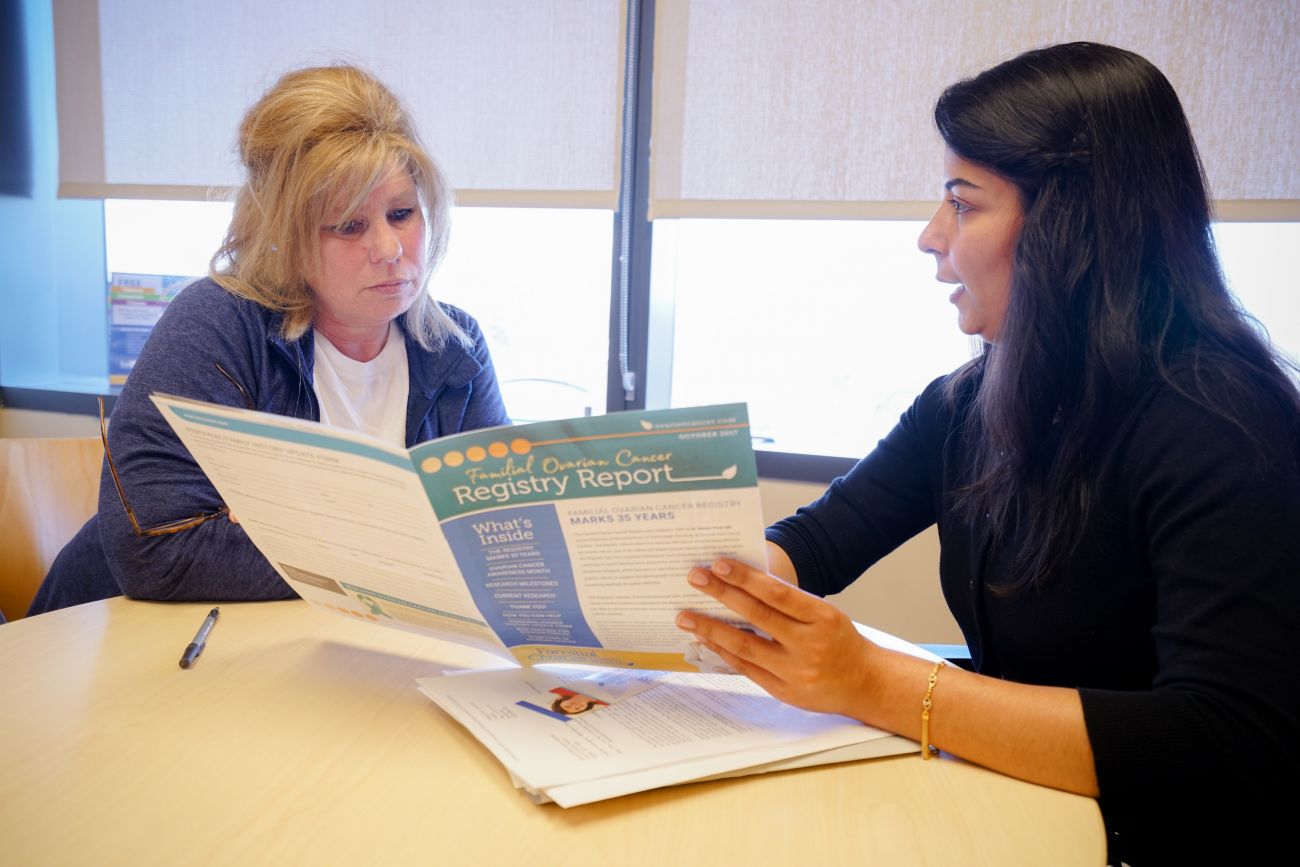Right now it’s estimated that 20-25% of all ovarian cancers are caused by a gene mutation (abnormality). But that number is expected to grow as scientists zero in on previously undiscovered mutations — and 2,700+ families across the nation are speeding the research.
The families — all with a higher-than-average risk for the disease — have contributed information and biospecimens to the Familial Ovarian Cancer Registry at Roswell Park. Created in 1981, the registry is the largest and oldest resource of its kind in the world, storing data and samples from more than 50,000 people.
By studying similarities in those people and tracing connections between their blood relatives, researchers are helping solve the mysteries of a disease that is usually diagnosed in the late stages, when it is harder to treat. Understanding who is at risk — and why — “could fuel new ways to prevent and treat ovarian cancer,” says Kunle Odunsi, MD, PhD, Deputy Director of Roswell Park and Co-Director and Principal Investigator of the registry. “The registry potentially accelerates our ability to discover new genes, because those new genes will be more concentrated in those high-risk families.”
New Insight: Daughters Can Inherit Risk From Fathers
Earlier this year, using information and biospecimens stored in the registry, a team of Roswell Park researchers identified a previously unknown gene called MAGEC3. The team found evidence that a MAGEC3 mutation, passed along to children by their fathers through the male X chromosome, increases a daughter’s risk of developing ovarian cancer at an earlier-than-average age, and a son’s risk of developing prostate cancer at an earlier age. Previously it was believed that risk for ovarian cancer was passed down by mothers only.
The registry’s value lies partly in the fact that it uses “very stringent criteria” to determine who’s eligible to contribute, adds Dr. Odunsi. Participants must meet one of these four criteria:
- A family history of two or more cases of ovarian cancer.
- A family history of three or more cases of cancer on the same side of the family, with at least one being ovarian cancer.
- A family history of at least one female with two or more primary cancers, with one of the primary cancers being ovarian cancer.
- A family history of two or more cases of cancer, with at least one being ovarian cancer diagnosed at an early age (45 or younger).
Jasmine Kaur, Project Director of the Familial Ovarian Cancer Registry, reviews Roswell Park clinic records every day to see if any new ovarian cancer patients meet those criteria. If a woman is eligible, Kaur meets with her after her clinic visit to explain the registry and ask if she’s interested in joining. While some women want time to think about it, over the past two years, only one person has declined.
For most participants, the opportunity to contribute to the registry is “a happy thing,” says Kaur, because it supports research that may help protect others, including their loved ones. “We know so much more about breast cancer than ovarian cancer. Ovarian cancer is notorious. It doesn’t have any particular symptoms, and we don’t have a screening test.”
Never miss another Cancer Talk blog!
Sign up to receive our monthly Cancer Talk e-newsletter.
Sign up!'Very Precious' Biosamples
Dr. Odunsi points out that most families in the registry come from outside Western New York. They visit the registry’s website and fill out a brief questionnaire, which Kaur reviews to determine whether or not they are eligible to participate. If so, she uses the information provided to create a pedigree map that helps trace occurrences of ovarian cancer in the person’s extended family.
She also requests biospecimens to be stored for research. Usually this involves a blood sample or buccal swab (sample of cells from the inside of the cheek). The registry sends out a kit for the collection. If a blood sample is needed, it can be collected by the participant’s primary care provider or local diagnostic lab, anywhere in the nation, and returned to the registry in the FedEx package provided.
What happens when the sample arrives at Roswell Park? “We take the white cells from the blood and ‘immortalize’ them so they will never die,” explains Dr. Odunsi. “We also extract the DNA for genomic and genetic analysis.”
The samples are then stored in liquid nitrogen tanks at Roswell Park. “It’s like a treasure trove,” Dr. Odunsi says. “They’re protected with alarms and backup power. They are very precious to us; we treat the tanks like babies.”
The registry is equally precious to researchers outside Roswell Park. The data and biospecimens — de-identified to protect the contributors’ privacy — are shared with researchers at institutions across the U.S. and in other countries, including members of the Ovarian Cancer Association Consortium, the largest consortium in the world focused on identifying genetic risks for ovarian cancer.
That relationship multiplies the registry’s power to chip away at the secrets of the disease, and the power grows with every new family who registers.
The Familial Ovarian Cancer Registry and the research it supports, including the MAGEC3 project, are made possible by generous donations to the Roswell Park Alliance Foundation.
Learn about the Roswell Park / University of Pittsburgh Cancer Institute Ovarian Cancer SPORE, which drives groundbreaking research aimed at increasing the survival rate for ovarian cancer.
